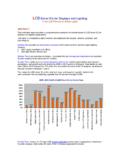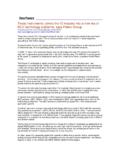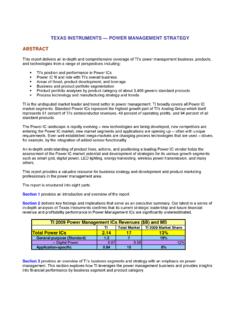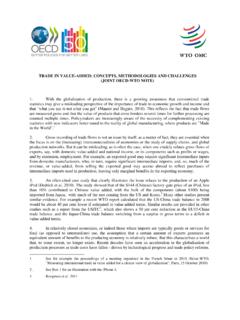Transcription of Texas Instruments Business Model -- Making …
1 Texas Instruments Business Model -- Making Products, Selling Solutions, says Petrov Group PALO ALTO, CA (Press Release) September 17, 2012 ---- The Petrov Group has announced a new 333-page/211-figure report titled Texas Instrument's Power Business Edition 2012 . Texas Instruments (TI), the largest analog IC vendor, is an undisputed market leader (nearly two times larger than its next competitor) and trend-setter in power management. That its products broadly cover all power IC market segments is well known. Solution Factor What is less well known is that, unlike most of its competitors, TI makes products but sells system solutions. The difference from its competitors is that TI does this on a grand scale and has created a one- of-a-kind Business machine, according to The Petrov Group. For years Petrov Group has measured the effectiveness of TI's solution strategy by using the S-factor concept.
2 The solution factor is defined as the ratio of revenue or profit contributed by the supporting analog versus strategic system components of a solution. Market Dominance TI's power Business strategy is supported by its patent strategy and market dominance (a stream of eight new catalog products per day). TI has a 29% revenue share among the Top-10 analog IC companies of that 26% in catalog products and 42% in custom products In catalog products TI has a 35% revenue share in function-oriented catalog products while only 10% in applications-oriented catalog products a category dominated by European vendors and Skyworks and frequently also referred to as ASSP products In functions-oriented catalog products (frequently referred to as general purpose products), TI has a 40% revenue share in power chain and 36% in signal chain products among the Top-10. vendors these vendors are significantly different from the Top-10 analog IC companies Analog IC Market Share of Top-10 Vendors (CY 2011).
3 TI. 14%. STM. All Other 10%. 43%. ADI. 6%. Maxim 6%. Infineon 5%. NXP ON. National Linear Skyworks 4% Semi 3%. 3% 3% 3%. In CY 2011 TI semiconductor revenues, including only 4Q12 National acquisition revenues, were $11B. (total TI revenues were $ ). TI's portfolio of catalog products contains about 60,000 products, of which more than 42,000 are analog products of which more than 20,000 are power products. Twelve Power Domains In order to enable a meaningful and useful analysis of power product portfolios Petrov Group developed a Model which categorizes them into twelve distinct power domains TI participates in all twelve power domains. TI's power Business revenues of $3B in 2011 are from two product types Catalog - $ and Custom - $ TI's power products are confined to three out of four Business units of TI's Analog Business : Power Silicon Valley Analog (SVA, former National Semiconductor), and High-volume Analog & Logic (HVAL).
4 The fourth Business unit, High-performance analog (HPA), addresses signal chain products. Two Core Technology and product Portfolios Unlike TI's financial reporting of Business segments, TI's core technologies and product portfolios should be segmented into only two areas: Analog signal and power management, and Embedded processing The Wireless Business segment seen in TI's financial reporting focuses on the unique aspects of the cell- phone Business supported by the above two core technology areas it focuses on wireless connectivity RF products and OMAP mobile application processors. The implication is that mixing financial reporting Business segments with core technologies and product types leads to misleading conclusions about TI's Business . Although the Wireless Business segment is in TI's financial reporting, in terms of technology IP and product portfolio Wireless is of limited importance.
5 This Business segment is under ever-increasing competitive pressure from IC vendors sharply focusing on handset type mobile applications such as Qualcomm, MediaTek and Broadcom and OEMs with proprietary mobile platforms such as Apple and Samsung. Leadership in Low-cost Processing and Packaging Technologies TI leads the industry in advanced packaging technologies used for power products driven by the need for higher power density of power solutions, thermal considerations, and higher switching speeds of higher voltage devices. Higher power density is achieved with higher power devices packaged in a smaller footprint. This, in turn, drives the need for smaller footprint packages featuring superior thermal capability. A representative example is TI's patented PowerStack package housing two synchronous power MOSFETs (TI's NexFETs) used in the power stage of synchronous switching DC/DC buck (step-down).
6 Converters. TI has in place all the needed processing and packaging technologies required to successfully compete in all areas of the analog and embedded processing Business . In terms of analog Business these capabilities include: In-house manufacturing of practically all products A complete portfolio of processing technologies required to implement its products $12B worth of revenues in additional manufacturing capacity Significant cost advantage using 300mm wafers (30% lower cost compared to 200mm wafers). Leading edge packaging technologies, especially for power products Large R&D resources developing the next generation technologies TI maintains its leadership by a stream of processing, packaging and manufacturing patents As a result, TI's competitors are compelled to specialize in areas outside TI's primary market targets, large enough to provide growth, but small enough to be of limited interest to TI.
7 TI could be viewed as the Intel of the analog Business ; hence, what applies to competing with Intel also applies to competing with TI. TI's Patent Strategy Patents represent TI's powerful and profitable historic asset as well as a competitive weapon. In fact, TI. was the first semiconductor vendor to turn its patent portfolio into a money Making Business in the mid- 1980s. TI's patent portfolio of published patent applications and patents (up to July 12, 2012). includes 5,247 published applications and 17,665 issued patents. During the recent 1-year period TI has generated about 1,650 published patent applications and acquired 2,050 issued patents. Three power domains stand out -- analog power conversion, battery power, and lighting & display power. Analog IC product Terminology There are only two analog product types that can be sold catalog and custom products. Custom are referred to as ASICs when jointly developed with a customer.
8 Catalog products can be: Function-oriented (sold regardless of end-equipment system) and Application-oriented (ASSP sold as optimized in functionality and performance for a limited number of end-equipment systems). The above terminology refers to products that are sold. It should not be mixed with terms like general purpose and application-specific which are application-oriented terms a source of much confusion in various market assessments. 2011 Revenue Share of Top-10 Analog IC Companies Linear National 5%. Skyworks 6%. 6%. TI. ON Semi 24%. 6%. NXP. 6%. Infineon STM. 9% 17%. Maxim ADI. 10%. 11%. 2011 Revenue Share of Top-10 Catalog Analog IC Vendors National Linear 6%. 7%. Skyworks 7% TI. 20%. ON Semi 5% STM. NXP 11%. 8%. Infineon ADI. 10% 14%. Maxim 12%. 2011 Revenue Share of Top Custom Analog IC Vendors Infineon NXP. 4% 1%. Maxim ON Semi 1% 10%. TI. 42%. STM. 42%. Analog IC Vendor Definition Recently there were several different lists of analog vendors published with much revision of analog IC.
9 Vendor ranking. The confusion stems from the definition on what makes a company an analog IC vendor. An Analog IC Company is in Petrov Group reports defined as an IC vendor that develops and sells ICs that are confined to the analog part of the Analog-Digital spectrum of an IC's functional content. These ICs feature a high degree of analog or analog-intensive functional content. They could be function specific ( , an operational amplifier) or application specific ( , an RF power amplifier). PG Definition of an Analog IC Vendor Representative companies focusing on the analog functional content include traditional analog IC. companies, including TI, Analog Devices, Maxim, and Linear Technology. Representative companies focusing on the analog-intensive functional content include STMicroelectronics, Infineon, NXP, and Skyworks Solutions. The boundary between the analog/analog-intensive and mixed-signal parts of the Analog-Digital spectrum is vaguely defined, hence, left to interpretations.
10 Two key attributes of an Analog IC Company in the PG. Model include: 1 Analog and analog-intensive ICs represent the company's primary and dominant Business in terms of revenues and product portfolio. 2 The company addresses and competes in the broader analog market featuring thousands of users (horizontal markets). Some IC vendors in the middle, mixed-signal, part of the Analog-Digital spectrum also provide power management ICs, typically as part of their chipsets, such as Qualcomm. Qualcomm is not, however, an analog IC vendor because it does not meet our second condition. Qualcomm's pursuit of emerging wireless power charging for mobile devices and electric vehicles represents an extension of its core wireless signal Business rather than an entry into the broader analog IC Business . A large number of vendors are mixed-signal vendors, , Broadcom. TI Revenue Share in Power Catalog ICs The focus of Petrov Group's major new report on TI's power Business is TI's catalog power products.








